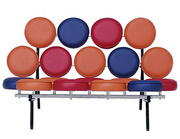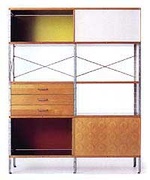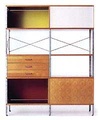When most people think of Mid-Century Modern, they conjure images of kidney-shaped coffee tables, boomerang-patterned lampshades, and wall clocks that explode in starbursts and other radiating designs. But in the 1930s, long before Mid-Century Modern was the definition of cool in Madison Avenue corner offices and Palm Springs living rooms, an architect and designer named Kem Weber was helping define a sleek, unfussy look that would become all the rage in the years that followed. As for his assemble-it-yourself Airline Chair (below), it was decades ahead of IKEA.
This fall, the Los Angeles County Museum of Art (LACMA) gives Weber and numerous other designers their due with California Design, 1930–1965: “Living in a Modern Way.” Curated by Wendy Kaplan and Bobbye Tigerman of the museum’s department of Decorative Arts and Design, the show runs from October 1, 2011 until March 25, 2012.
“One of the things we’re most excited about in our show,” says Tigerman, “is a re-creation of a room Weber designed for the 1939 Golden Gate International Exposition on Treasure Island. It was a huge world’s fair with numerous pavilions, including one for fine arts.
“In addition to the typical museum displays,” continues Tigerman, “curator Dorothy Liebes invited architects and designers to create model rooms to show people how they might live in the future. One of the architects she invited was Kem Weber, who designed a living room that reflected his interest in streamlined shapes and displayed his use of color. We’ve been able to find several of the pieces of furniture that were actually shown in that room, so our exhibition will give visitors a sense of what was considered avant-garde in 1939.”

Kem Weber’s Airline Chair was designed to be packed in a cardboard container and assembled by the customer.
According to author and professor Christopher Long of the University of Texas at Austin, 1939 was one of the last years when Weber’s work was considered avant-garde. “Weber was among the best known designers in America at that time, and certainly very well known in California,” says Long. But for the new crop of designers like Charles and Ray Eames, he says, “Weber would’ve been an old fuddy-duddy. They were a whole generation younger—he would’ve been old enough to be Charles’s father.”
Still, adds Long, “It’s hard for me to imagine that the Eameses didn’t look at what he was doing and weren’t inspired at some level by his work.”
Then, as now, what most people knew Weber for was his Airline Chair of 1934. With a suggested retail price of $24.75, the chair was shipped in a cardboard box, unassembled. Sounds like the perfect piece of furniture for a design-focused customer in the midst of the Great Depression, right? Wrong. Only 200 or so of the chairs were ever produced—Weber’s Airline Chair essentially never got off the ground.
“It’s probably the first example of a piece of furniture sent home in a box that was intended to be put together by the consumer,” says Long. “It was revolutionary,” he says, “absolutely revolutionary.” Today, thanks to IKEA, assemble-it-yourself furniture sounds obvious, but IKEA was not founded until 1943, and did not rise to international retail prominence until the 1960s and ’70s.
“Weber certainly sold more outlandish designs than that,” says Long, “so I think the chair’s failure had a lot to do with the fact that people in the furniture industry simply didn’t think they could sell it.” Weber’s aesthetic may have struck some of his younger contemporaries as quaint, but in other ways he was perhaps a bit too ahead of his time.
(Airline Chair photo courtesy of LACMA; chair-assembly photos courtesy the Kem Weber Collection, Architecture & Design Collection, University Art Museum, University of California, Santa Barbara; Imogene Cunningham portrait courtesy of so-cal-arch-history.com; to learn more about another prominent designer of this period, read Christopher Long’s “Paul T. Frankl and Modern American Design.” If you buy something through a link in this article, Collectors Weekly may get a share of the sale. Learn more.)



 Eames, Nelson, and the Mid-Century Modern Aesthetic
Eames, Nelson, and the Mid-Century Modern Aesthetic
 Mid-Century Modern Furniture, from Marshmallow Sofas to Hans Wegner Chairs
Mid-Century Modern Furniture, from Marshmallow Sofas to Hans Wegner Chairs Eames, Nelson, and the Mid-Century Modern Aesthetic
Eames, Nelson, and the Mid-Century Modern Aesthetic 'Mad Men' Prop Master Scott Buckwald Explains How He Re-Creates the '60s
'Mad Men' Prop Master Scott Buckwald Explains How He Re-Creates the '60s Mid-Century ModernMid-Century Modern describes an era of style and design that began roughly …
Mid-Century ModernMid-Century Modern describes an era of style and design that began roughly … Mari Tepper: Laying it on the Line
Mari Tepper: Laying it on the Line Nice Ice: Valerie Hammond on the Genteel Charm of Vintage Canadian Costume Jewelry
Nice Ice: Valerie Hammond on the Genteel Charm of Vintage Canadian Costume Jewelry How Jim Heimann Got Crazy for California Architecture
How Jim Heimann Got Crazy for California Architecture Modernist Man: Jock Peters May Be the Most Influential Architect You've Never Heard Of
Modernist Man: Jock Peters May Be the Most Influential Architect You've Never Heard Of Meet Cute: Were Kokeshi Dolls the Models for Hello Kitty, Pokemon, and Be@rbrick?
Meet Cute: Were Kokeshi Dolls the Models for Hello Kitty, Pokemon, and Be@rbrick? When the King of Comedy Posters Set His Surreal Sights on the World of Rock 'n' Roll
When the King of Comedy Posters Set His Surreal Sights on the World of Rock 'n' Roll How One Artist Makes New Art From Old Coloring Books and Found Photos
How One Artist Makes New Art From Old Coloring Books and Found Photos Say Cheese! How Bad Photography Has Changed Our Definition of Good Pictures
Say Cheese! How Bad Photography Has Changed Our Definition of Good Pictures Middle Earthenware: One Family's Quest to Reclaim Its Place in British Pottery History
Middle Earthenware: One Family's Quest to Reclaim Its Place in British Pottery History Fancy Fowl: How an Evil Sea Captain and a Beloved Queen Made the World Crave KFC
Fancy Fowl: How an Evil Sea Captain and a Beloved Queen Made the World Crave KFC
“Sounds like the perfect piece of furniture for a design-focused customer in the midst of the Great Depression, right? Wrong”
But for a different reason:
In 2010, the relative worth of $24.75 from 1937 is:
$376.00 using the Consumer Price Index
$306.00 using the GDP deflator
$820.00 using the unskilled wage
$1,050.00 using the Production Worker Compensation
$1,640.00 using the nominal GDP per capita
$3,950.00 using the relative share of GDP
using the calculation of this site, I found googling:
http://www.measuringworth.com/uscompare/
your link to the CA design exhibit is wrong. it should be this: http://www.lacma.org/about/press/california-design-1930–1965-“living-modern-way” -Thanks for catching this, fixed!